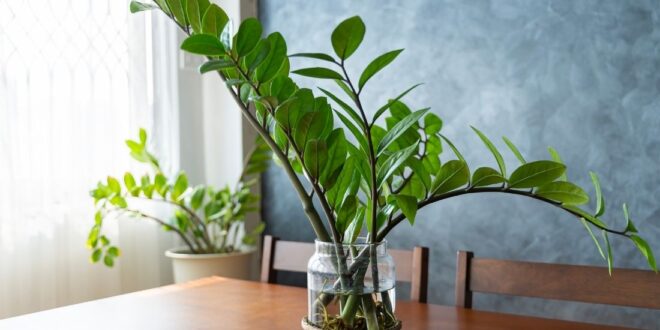Let’s Meet ZZ Plant

The ZZ plant, scientifically known as Zamioculcas zamiifolia, has become a beloved fixture in many modern homes. With its glossy, waxy leaves and easy-care nature, this plant embodies both elegance and resilience. Whether you’re a beginner or a seasoned plant enthusiast, the ZZ plant offers a perfect blend of beauty and practicality. Let’s delve into its characteristics, care tips, and why it’s a must-have for your home.
Defining the ZZ Plant: Glossy Leaves, Rhizomes, and Overall Appearance
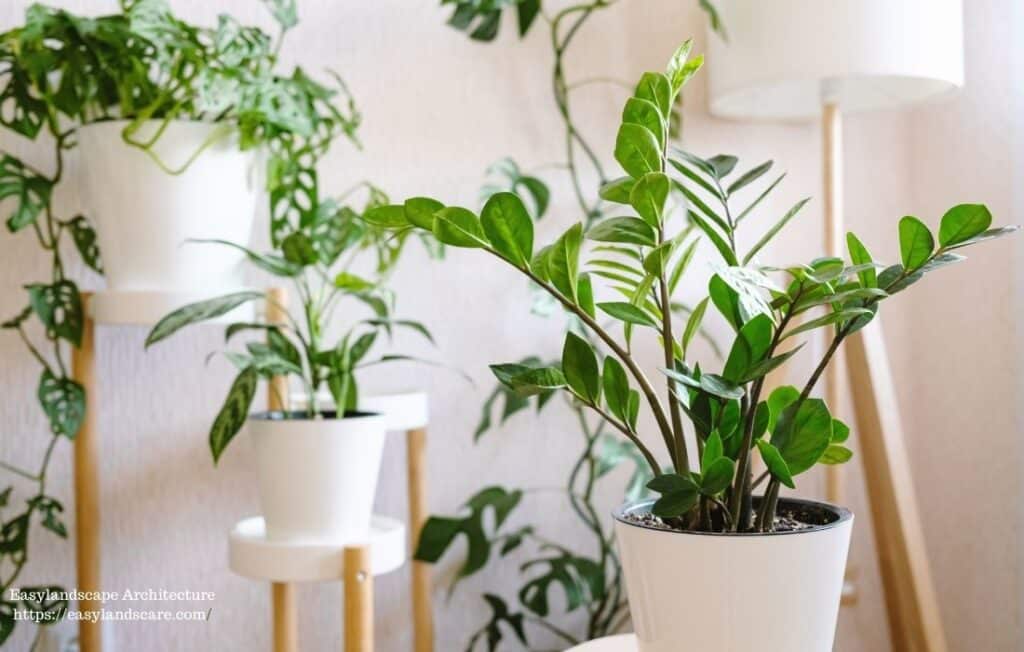
One of the most striking features of the ZZ plant is its glossy, dark green leaves. These leaves grow in pairs along thick, sturdy stems, creating a sophisticated look that complements any interior. The waxy surface of the leaves reflects light, adding a touch of glamour to your space. Beneath the soil, the ZZ plant has a unique root system made up of rhizomes—tuber-like structures that store water and nutrients. This adaptation enables the plant to endure long periods of drought, making it incredibly low-maintenance. Its slow growth rate ensures that it maintains its neat form for an extended time, further enhancing its appeal.
Origins of the ZZ Plant: Africa’s Hardy Treasure
Native to East Africa, the ZZ plant thrives in the arid and semi-arid regions of countries such as Kenya, Tanzania, and Zanzibar. This origin explains its remarkable drought tolerance and ability to survive in challenging conditions. Although it has been known to local populations for centuries, its introduction to the Western world and subsequent popularity as an indoor plant is relatively recent. The ZZ plant’s resilience and adaptability make it a symbol of endurance and strength.
Different Names for the ZZ Plant and Their Meanings
ZZ Plant: This is the most common name and is simply a shortened, catchy version of its scientific name, Zamioculcas zamiifolia.
Zanzibar Gem: This name refers to the plant’s origin in Eastern Africa, including Zanzibar. The “Gem” part describes its shiny, waxy leaves that are so perfect they look like polished stones.
Eternity Plant (or Everlasting Plant): This name highlights the plant’s incredible resilience and longevity. It can survive for very long periods with minimal care, tolerating drought and low light, giving it a reputation for “living forever.”
Aroid Palm: Although it is not a true palm tree, this name comes from its upright growth habit and feather-like leaves that resemble a palm frond. The “Aroid” part correctly places it in the Araceae family of plants.
Zuzu Plant: This is simply a playful, rhyming nickname derived from the “ZZ” abbreviation, making it easy to remember.
Emerald Palm: This name refers to the plant’s vibrant, glossy green leaves. The word “Emerald” emphasizes the foliage’s rich color and precious, gem-like appearance.
What are the Different Types of ZZ Plants?
While the primary species is Zamioculcas zamiifolia, several cultivars with varying colors and sizes have been developed:
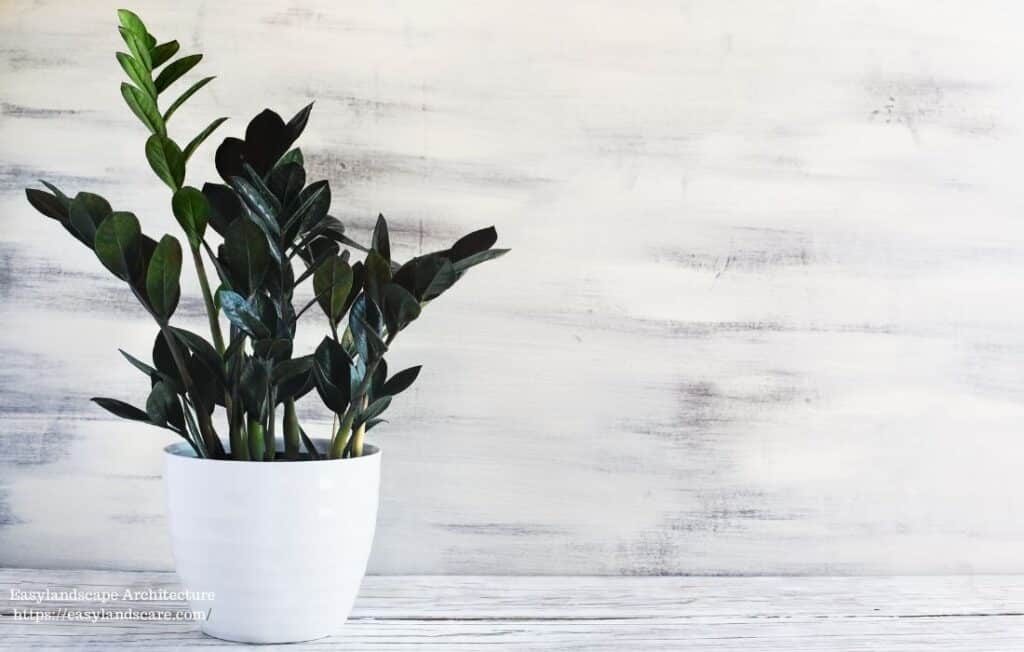
Raven ZZ Plant
One of the most sought-after cultivars, ‘Raven’ starts with bright green new growth that gradually darkens to a deep purple or black as it matures. This color transformation adds a modern and dramatic touch to any decor.
Zenzi ZZ Plant
Known as the dwarf ZZ, ‘Zenzi’ features a more compact growth habit with shorter, densely packed leaves compared to the standard variety. It’s perfect for smaller spaces and adds a charming touch.
Variegata ZZ Plant
A rarer cultivar, ‘Variegata’ showcases yellow or white streaks and patches on its leaves, adding a lighter and eye-catching element to its appearance.
The Standard Green ZZ Plant
The classic variety, with its glossy, dark green leaves, remains the most common and is prized for its hardiness and ability to adapt to various indoor environments.
How to Care for a ZZ Plant?
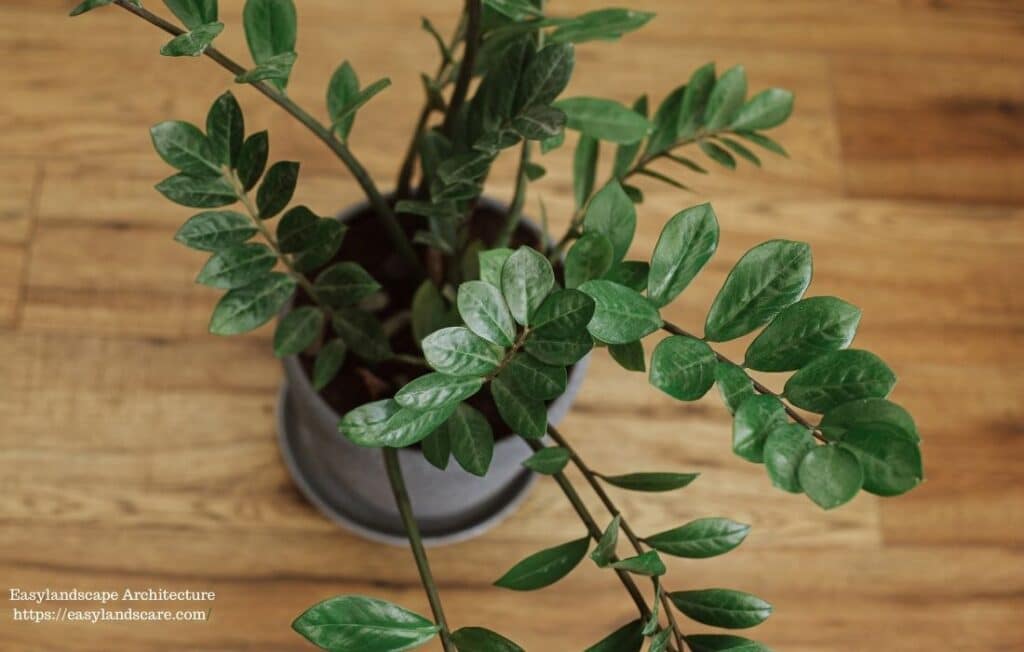
The ZZ plant is renowned for its low-maintenance nature, making it an excellent choice for busy individuals or those new to plant care. Here are some essential care tips:
Ideal Light Levels: Tolerant of Low to Bright, Indirect Light
The ZZ plant is exceptionally tolerant of low light conditions and can survive in dimly lit corners. However, it flourishes best in bright, indirect light. Be cautious with direct sunlight, as it can scorch the leaves.
Watering Needs: Absolutely Avoid Overwatering
The most crucial rule in ZZ plant care is to avoid overwatering. Its rhizomes store water, so excessive moisture can lead to root rot. Allow the soil to dry out completely between waterings, and then water thoroughly. During winter, reduce watering significantly.
Soil and Pot Selection: Good Drainage is Vital
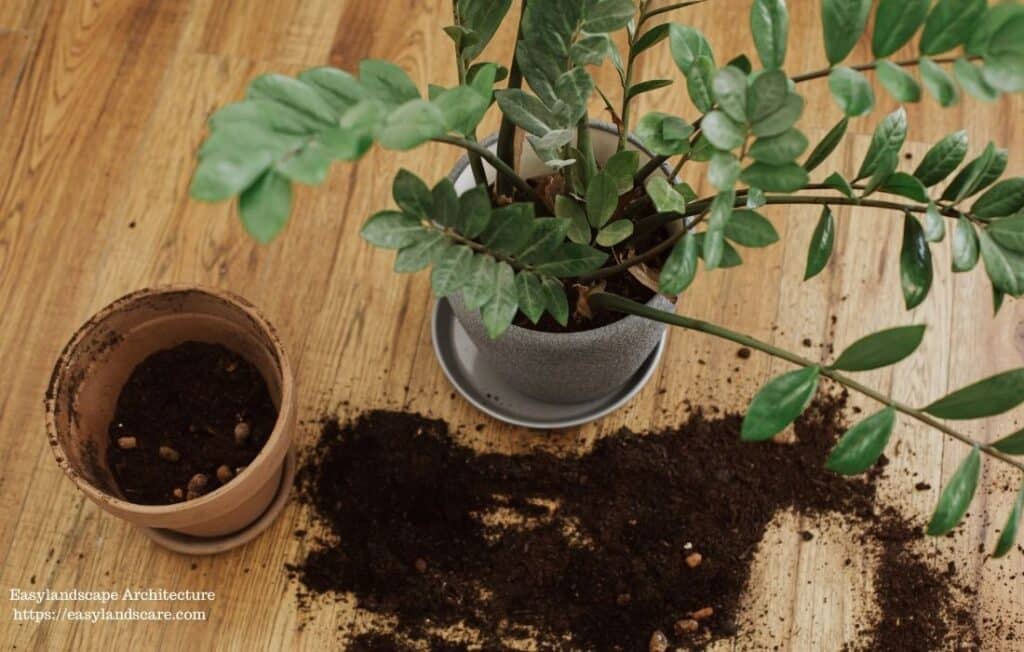
Using a well-draining potting mix is essential for ZZ plants. A cactus and succulent mix or a standard potting mix amended with perlite or sand to improve drainage is ideal. Choose a pot with drainage holes to allow excess water to escape, minimizing the risk of root rot.
How to Propagate a ZZ Plant? Methods That Require Patience
Propagating ZZ plants is generally slower compared to many other houseplants, but patience will reward you with new plants.
Propagating by Leaf Cuttings: A Lengthy Process
Carefully cut a healthy leaf from the plant and allow the cut end to callous over for a few hours. Then, insert the cut end about 1-2 cm deep into moist potting mix. Keep the soil consistently moist and provide bright, indirect light. Rooting and the development of new rhizomes can take several months.
Propagating by Rhizome Division: Applicable During Repotting
When repotting a mature ZZ plant, you can divide the rhizomes. Gently separate the root system, ensuring each division has at least one healthy stem. Plant each division in its own pot with fresh potting mix and resume normal care.
Propagating by Stem Cuttings: A Potentially Faster Method
Cut a healthy stem from the plant, removing the lower leaves. Allow the cut end to callous over for a few hours. Then, insert the stem into moist potting mix or try rooting it in water. Water rooting may yield faster results, but it’s crucial to transfer the rooted stem to soil once sufficient roots have developed.
The Most Suitable Light and Temperature Conditions for a ZZ Plant
While adaptable, providing the right environment will support healthy growth.
Ideal Temperature Range: Room Temperature is Usually Sufficient
ZZ plants thrive in normal room temperatures between 65-75°F (18-24°C). Avoid exposing them to extreme heat or cold.
Light Tips: Growing ZZ Plants in Different Environments
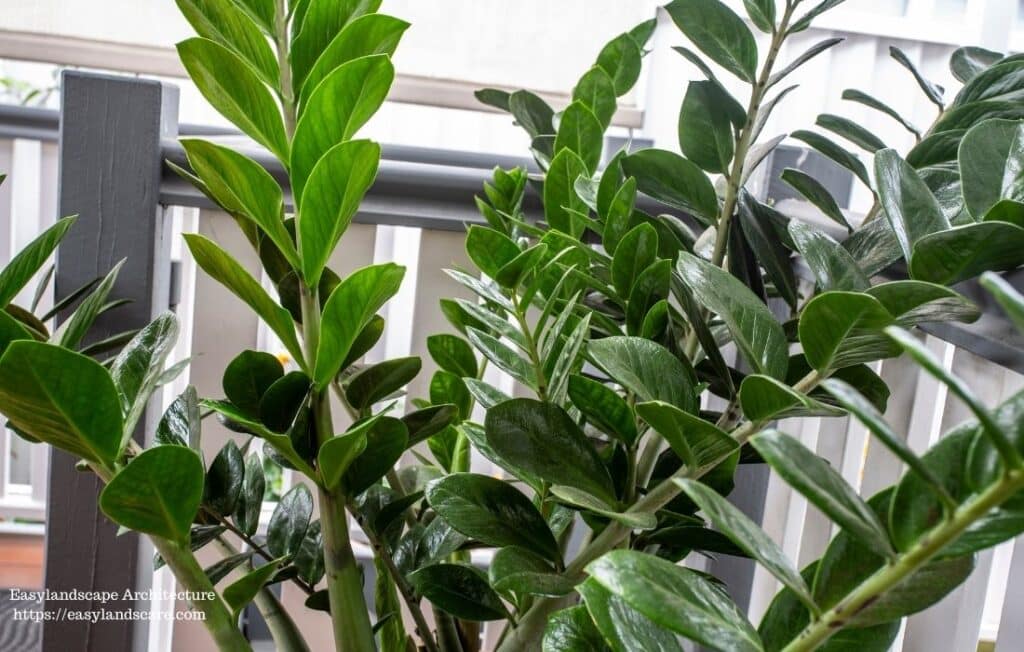
While tolerant of low light, ZZ plants will grow more vigorously and maintain their rich color in bright, indirect light. If you notice new shoots are very thin and leggy, it may indicate insufficient light.
What Kind of Soil Does a ZZ Plant Prefer? Pot Selection and Tips
Choosing the right soil and pot is crucial for the ZZ plant’s well-being.
The Best Soil Mix: Options that Provide Good Drainage
As mentioned, well-draining soil is key. Opt for a cactus or succulent mix or amend regular potting soil with perlite, pumice, or sand to enhance drainage and aeration.
How to Choose the Right Pot Size and Material
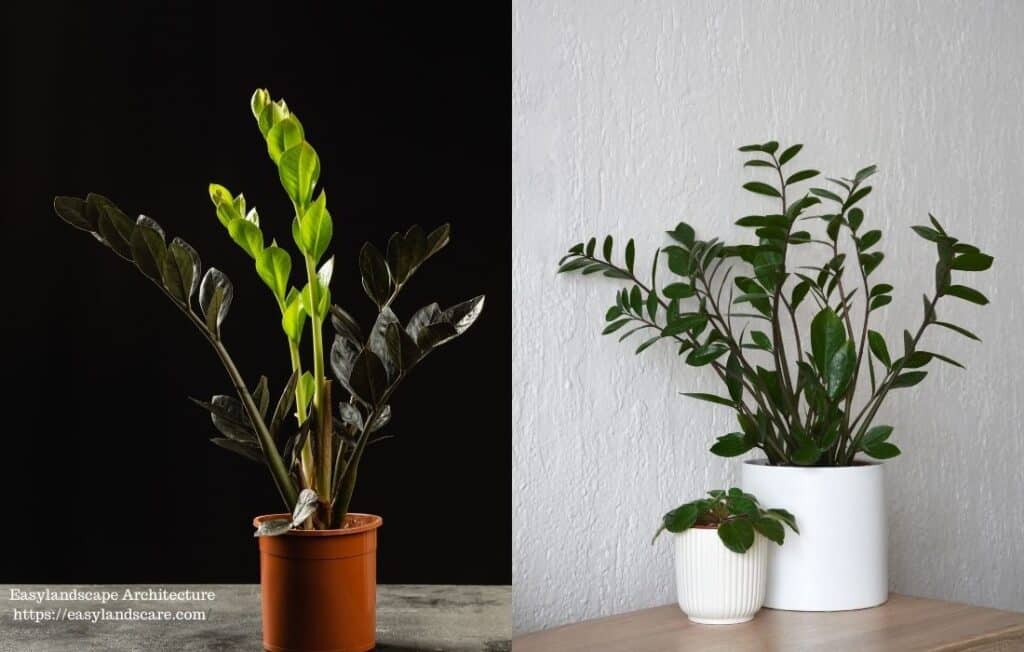
Ensure your pot has drainage holes. The size should be appropriate for the plant’s root system—not too large, which can retain excess moisture. While pot material isn’t as critical as drainage, terracotta pots can help the soil dry out faster due to their porosity.
ZZ Plant Watering Guide: How Often Should You Water?
Overwatering is the most common mistake in ZZ plant care.
Seasonal Watering Adjustments: Summer vs. Winter
During the active growing season (spring and summer), water when the top inch of soil feels dry. In the dormant winter months, reduce watering significantly, allowing the soil to dry out almost completely between waterings.
Signs of Overwatering and Underwatering
Yellowing leaves that are soft and mushy are often a sign of overwatering. Brown, crispy leaf tips can indicate underwatering, although ZZ plants are quite drought-tolerant. Drooping can occur with both extremes, so checking soil moisture is essential.
How to Fertilize a ZZ Plant?
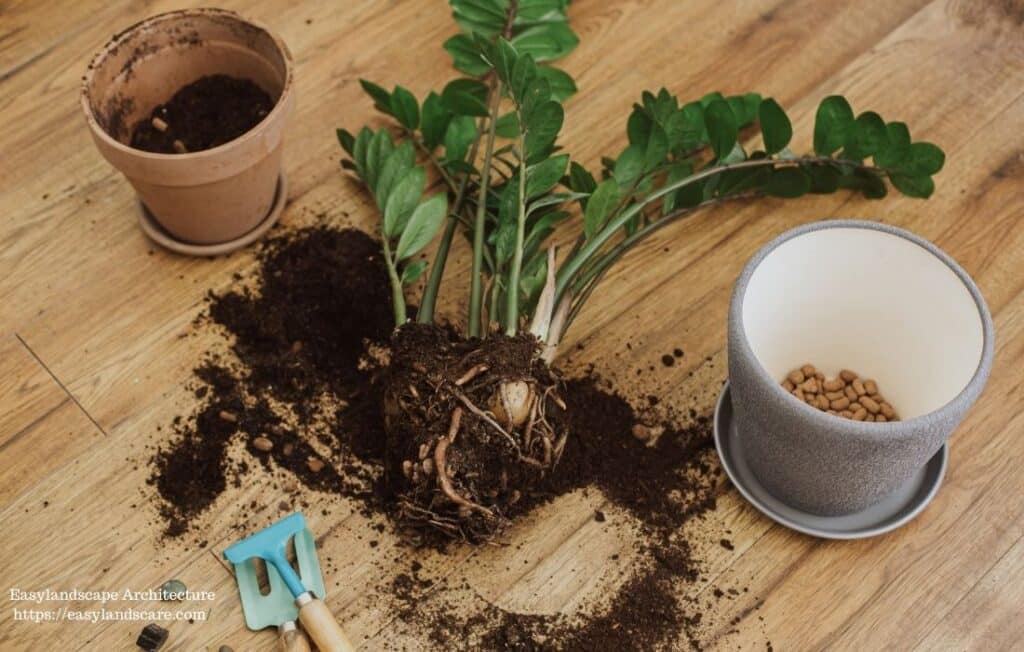
ZZ plants are not heavy feeders, but a little nourishment can promote healthy growth.
When and How Often to Fertilize
During the active growing season (spring and summer), you can fertilize your ZZ plant every 2-4 weeks with a diluted balanced liquid houseplant fertilizer. Withhold fertilizer during the fall and winter.
The Best Types of Fertilizer to Use
A balanced liquid fertilizer (e.g., 10-10-10 or 20-20-20) diluted to half strength is suitable for ZZ plants.
The Dangers of Over-Fertilizing
Over-fertilizing can lead to salt buildup in the soil and potentially burn the roots. It’s always better to under-fertilize than over-fertilize.
Why are ZZ Plant Leaves Turning Yellow? Causes and Solutions
Yellowing leaves can indicate a problem, but there are solutions.
Common Causes of Yellowing: Overwatering, Insufficient Light, and More
- Overwatering: The most frequent cause, leading to root rot.
- Insufficient Light: Prolonged lack of adequate light can stress the plant.
- Natural Aging: Older leaves will eventually turn yellow and drop off.
- Sudden Temperature Changes or Drafts: ZZ plants can be sensitive to drastic temperature shifts.
- Pests: Although rare, pests can sometimes cause leaf discoloration.
How to Prevent and Treat Yellowing
Identify the likely cause and adjust your care accordingly. Ensure proper watering habits, provide adequate indirect light, protect from temperature extremes, and inspect for pests.
Is the ZZ Plant Toxic? Is it Safe for Pets?
The ZZ plant contains calcium oxalate crystals, which can cause mild to moderate irritation if ingested. Therefore, it is recommended to keep it out of reach of cats, dogs, and other pets. If curious animals chew on the leaves or stems, they may exhibit symptoms such as:
- Irritation of the mouth and throat: This can lead to increased drooling, pawing at the mouth, or restlessness.
- Vomiting: Especially if a significant amount of plant material is ingested.
- Diarrhea: As a result of irritation in the digestive system.
- Loss of appetite: Due to discomfort in the mouth and throat.
While the symptoms are usually mild and temporary, it’s always best to consult with your veterinarian if you have any concerns. Placing the ZZ plant on high shelves, in hanging baskets, or in rooms inaccessible to your pets is a good preventative measure. Although the taste of the plant often deters animals, caution is advised, especially with young or particularly inquisitive pets.
You may also be interested in our detailed article on whether the ZZ plant is toxic to cats.
ZZ Plant for Home Decor: Sleek and Minimalist Touches
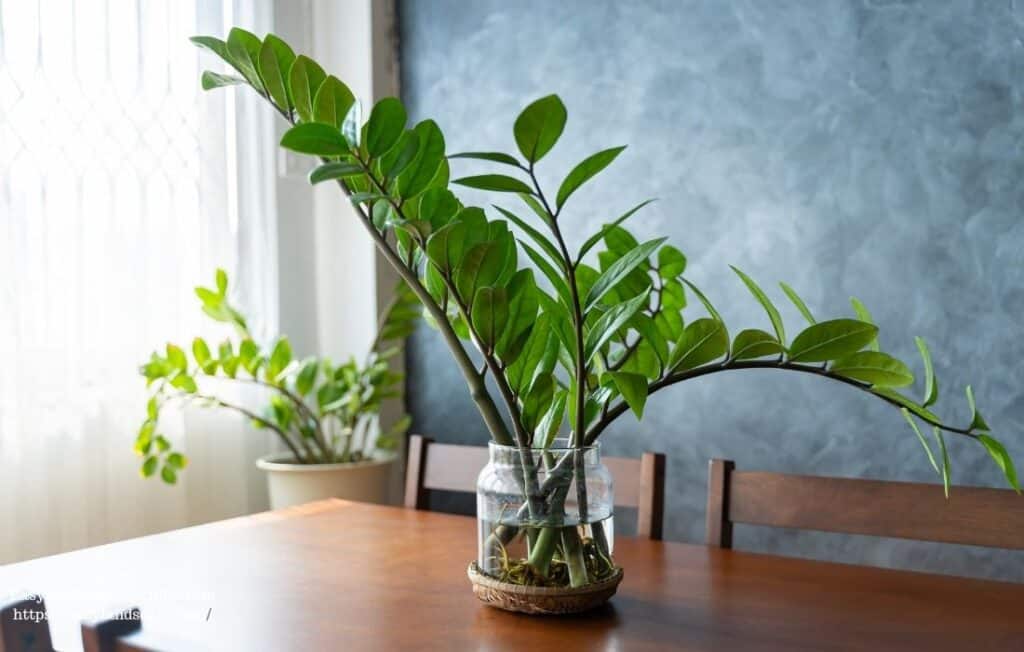
With its glossy, upright foliage, the ZZ plant complements modern and minimalist decor styles beautifully. It adds a touch of sophistication without being overly fussy. Its slow growth rate also means it maintains its tidy appearance for longer.
Benefits of ZZ Plants for Your Home: Air Purification and Stress Reduction
While not on NASA’s list of top air-purifying plants, some studies suggest ZZ plants can remove small amounts of certain airborne toxins like benzene, toluene, and xylene. Additionally, like many houseplants, they can contribute to a sense of calm and well-being.
ZZ Plant Diseases and Pest Control
ZZ plants are generally quite resistant to diseases and pests:
Common Diseases and Their Symptoms
The most common issue is root rot, caused by overwatering. Symptoms include yellowing, mushy leaves and a foul odor from the soil.
Most Common Pests and How to Get Rid of Them
ZZ plants are relatively pest-free, but occasionally, you might encounter mealybugs or spider mites, especially in humid or stressed conditions. Isolate the plant and try wiping off the pests. For heavier infestations, insecticidal soap or neem oil can be used.
How to Care for ZZ Plants in Winter
Winter care involves a few adjustments:
Reduced Watering and Fertilizing Needs
As the plant’s growth slows down in winter, reduce watering significantly and stop fertilizing altogether until spring.
Proper Placement and Temperature Control
Protect your ZZ plant from cold drafts and maintain a stable room temperature. Avoid placing it near heat sources like radiators, which can dry out the air excessively.
How Big Do ZZ Plants Get? Size and Growth Process
ZZ plants are slow growers and typically don’t reach massive sizes indoors. Mature plants can reach a height and spread of around 2-3 feet (60-90 cm). Growth rate depends on factors like light and overall care.
Why are ZZ Plants Popular? The Features That Make Them Unique
The ZZ plant’s popularity stems from several key features:
Effortless Care and Low Maintenance
Its ability to tolerate neglect, drought, and low light makes it incredibly appealing for busy individuals and plant care beginners.
Sleek and Modern Appearance
Its glossy, dark green foliage adds a touch of elegance and sophistication to any interior.
Resilience and Longevity
With proper care, ZZ plants can live for many years, maintaining their beauty and form.
Air-Purifying Qualities (Though Minor)
The potential for some air purification adds to its appeal as a beneficial houseplant.
With its combination of striking looks and remarkable resilience, the ZZ plant is a fantastic choice for adding a touch of green to your life with minimal fuss. Enjoy the effortless elegance of this enduring plant!

